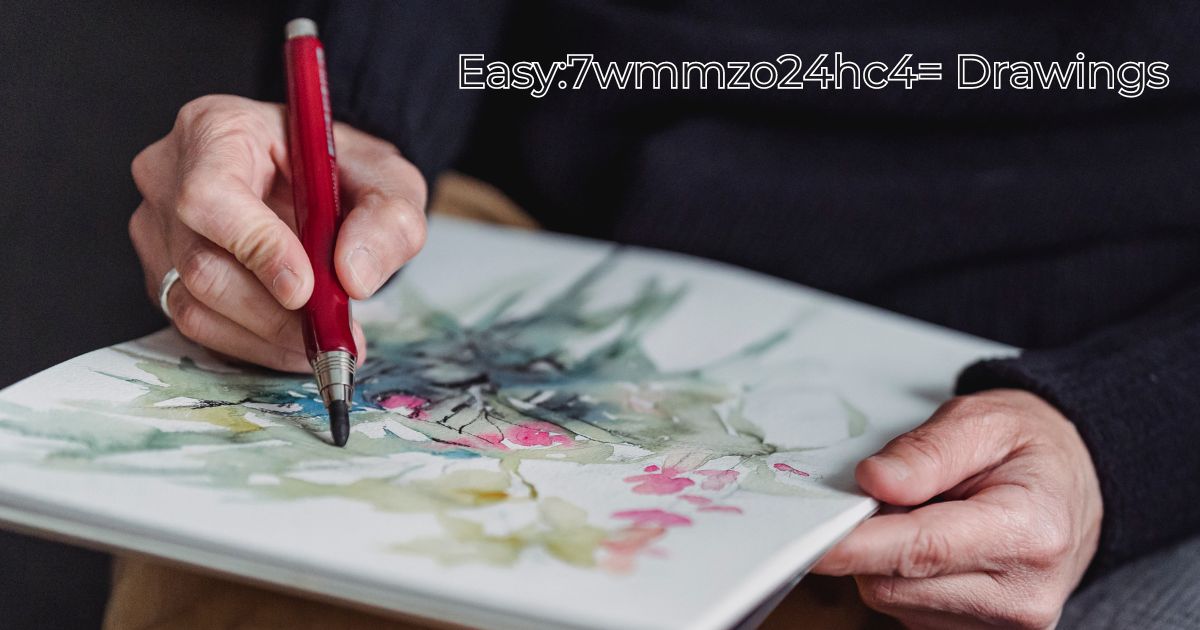Drawing is a universal form of expression that transcends age, culture, and skill level. Whether you’re a seasoned artist or a curious beginner, the desire to put pencil to paper can be both exciting and daunting. Among the many techniques available, easy:7wmmzo24hc4= drawings stand out for their accessibility and potential for creativity. These drawings emphasize simplicity and fundamental techniques, allowing anyone to dive into the world of art without the fear of making mistakes.
In this article, we’ll explore the simple steps that can guide you through the process of creating easy:7wmmzo24hc4= drawings. By breaking down the complexities of drawing into manageable parts, you’ll find that expressing yourself artistically is not only achievable but also enjoyable. Let’s unlock the secrets to drawing with confidence and clarity!
Understanding the Basics
What Are Easy:7wmmzo24hc4= Drawings?
At its core, easy:7wmmzo24hc4= drawings focus on using straightforward shapes and lines to create visually appealing images. These drawings are characterized by their minimalistic approach, where the emphasis is on conveying an idea or a feeling rather than achieving photographic realism. This method allows artists to explore their creativity without the constraints often associated with traditional drawing techniques.
The beauty of easy:7wmmzo24hc4= drawings lies in their accessibility. Artists of all skill levels can experiment with this style, as it encourages exploration and personal interpretation. For example, an easy drawing of a tree may consist of simple geometric shapes like circles for foliage and a rectangle for the trunk. By utilizing basic shapes, anyone can create a recognizable form, making art approachable and less intimidating.
The Benefits of Easy Drawing Techniques
Embracing easy:7wmmzo24hc4= drawings has numerous benefits, both for beginners and experienced artists. First and foremost, these techniques foster creativity. When artists aren’t burdened by complex details, they can focus on their imagination and ideas. This freedom can lead to innovative concepts that might not have emerged in more restrictive styles.
Additionally, easy drawings serve as a powerful tool for building confidence. Many aspiring artists struggle with self-doubt and fear of judgment, which can hinder their artistic journey. By starting with simple drawings, individuals can gradually build their skills and confidence. Completing a drawing—no matter how simple—provides a sense of accomplishment that encourages further exploration of the art form.
Gathering Your Supplies
Essential Materials for Easy:7wmmzo24hc4= Drawings
Before diving into the world of easy:7wmmzo24hc4= drawings, it’s important to gather the right materials. Fortunately, you don’t need an extensive list of supplies to get started. The basics include a good quality sketchbook, pencils, and erasers. A sketchbook allows you to practice without the pressure of perfection, while pencils provide the flexibility to create both light and dark lines.
In addition to traditional materials, consider adding colored pencils or markers for a splash of vibrancy. These tools can elevate your simple drawings, making them more visually appealing. For those who prefer digital drawing, a tablet and stylus can serve as excellent alternatives, allowing for easy corrections and limitless creativity. Remember, the key is to keep your workspace organized and clutter-free, as a clean environment promotes focus and inspiration.
Recommended Tools and Their Uses
When it comes to tools for easy:7wmmzo24hc4= drawings, each item serves a unique purpose. For example, a variety of pencils, such as HB for general sketching and 2B or 4B for shading, can help you achieve different effects. An eraser is equally important, as it allows for corrections and adjustments, fostering a stress-free drawing experience.
Additionally, consider investing in a ruler and compass for creating geometric shapes. These tools can simplify the process of drawing straight lines and perfect circles, essential components in many easy:7wmmzo24hc4= drawings. Lastly, a blending stump or tissue can help create smooth transitions in shading, adding depth to your artwork. By familiarizing yourself with these tools, you’ll set the stage for successful and enjoyable drawing sessions.
Choosing Your Subject
Selecting Simple Shapes for Easy:7wmmzo24hc4= Drawings
Choosing the right subject is crucial for creating easy:7wmmzo24hc4= drawings. Start by identifying simple shapes that can be easily combined to form recognizable objects. Common subjects include animals, plants, and everyday objects like cups or fruits. The goal is to break down these subjects into basic components, allowing you to approach drawing without feeling overwhelmed.
For instance, if you want to draw a cat, begin with basic shapes: an oval for the body, circles for the head and paws, and triangles for the ears. Once you have the foundational shapes, you can refine your drawing by adding details. This step-by-step approach not only makes the process manageable but also helps you understand the structure of the subject, enhancing your overall drawing skills.
Inspiration Sources: Nature, Objects, and More
Finding inspiration can sometimes be a challenge, but numerous sources can spark your creativity for easy:7wmmzo24hc4= drawings. Nature is a fantastic starting point. Observe the shapes of trees, flowers, and animals in your environment. You can even take photographs during your walks to reference later. This not only helps you see the beauty around you but also encourages you to draw from real life.
Everyday objects around your home or workspace can also serve as inspiration. Items like your favorite mug, a plant, or even your pet can be transformed into easy drawings. If you’re still looking for ideas, consider browsing online platforms like Pinterest or Instagram, where countless artists share their work. Create a mood board of your favorite easy:7wmmzo24hc4= drawings, and use it as a reference when choosing subjects for your projects.
The Drawing Process
Step 1: Sketching the Outline
Once you’ve selected your subject, it’s time to begin the drawing process. The first step involves sketching the outline, which acts as the foundation for your artwork. Start by lightly drawing the basic shapes you identified earlier. Don’t worry about perfection; this is merely a guideline that will help you visualize the final piece.
As you sketch, pay attention to the proportions and relationships between the different elements of your subject. For example, if you’re drawing a dog, observe how the head relates to the body and how the legs fit in. Use light strokes, as this will make it easier to erase and modify your outline as needed. Remember, the goal is to create a solid base without feeling constrained by detail at this stage.
Step 2: Adding Details
After establishing your outline, it’s time to add details that will bring your easy:7wmmzo24hc4= drawing to life. This is where you can begin to define the features of your subject. Focus on one section at a time, gradually adding details like facial expressions, fur texture, or patterns.
While working on details, remember to maintain a balance between simplicity and expression. Easy:7wmmzo24hc4= drawings thrive on minimalism, so choose details that enhance the overall look without overwhelming the composition. For example, if you’re drawing a flower, you might add simple lines to indicate petals without getting lost in intricate patterns. This technique keeps the drawing accessible while still conveying your artistic vision.
Step 3: Refining Your Drawing
Once you’re satisfied with the details, it’s time to refine your drawing. This step involves going over your initial outline, strengthening the lines you want to keep while erasing the unnecessary ones. Take your time during this process, as it can significantly impact the final appearance of your artwork.
As you refine, consider adding shading or color to enhance depth. Lightly shading areas where shadows would naturally fall creates a more three-dimensional effect. Similarly, if you’re using color, think about how different hues can highlight or emphasize particular aspects of your drawing. Refining your work is a crucial part of the drawing process and can transform a simple outline into a polished piece of art.
Also read: Immediate V2 Intal
Techniques for Easy:7wmmzo24hc4= Drawings
Using Grids to Simplify Proportions
One effective technique for creating easy:7wmmzo24hc4= drawings is the use of grids. By overlaying a grid on your reference image and another on your drawing paper, you can break the image into smaller, manageable sections. This method allows you to focus on one square at a time, making it easier to capture proportions and details accurately.
Using grids is particularly helpful for beginners who may struggle with proportions. By concentrating on smaller areas, you can improve your skills and gain confidence in your drawing abilities. As you become more comfortable with this technique, you may find that you rely on grids less frequently, allowing your natural artistic style to emerge.
The Power of Minimalism in Easy Drawings
Minimalism is a fundamental aspect of easy:7wmmzo24hc4= drawings, emphasizing simplicity and clarity. By focusing on essential elements, artists can convey their message effectively without unnecessary clutter. This technique encourages viewers to engage with the artwork on a deeper level, as they are invited to interpret the simplicity.
To incorporate minimalism into your drawings, consider limiting your color palette and reducing the number of elements in your composition. Instead of overcrowding your piece with details, allow negative space to play a role in your artwork. This not only creates balance but also highlights the focal points, drawing attention to the most important aspects of your drawing. Minimalism can transform your easy:7wmmzo24hc4= drawings into striking and thought-provoking pieces.
Common Mistakes to Avoid
Overcomplicating Your Drawings
One of the most common pitfalls for aspiring artists is overcomplicating their drawings. In the quest for perfection, many individuals tend to add unnecessary details or intricate patterns that can detract from the overall composition. Remember, easy:7wmmzo24hc4= drawings thrive on simplicity and clarity.
To avoid this mistake, focus on the essential elements of your subject. Ask yourself which details are truly necessary to convey the idea or emotion you wish to express. Simplifying your drawing can enhance its impact and allow viewers to appreciate your artistic intention more fully. Always remind yourself that less can be more; sometimes, a straightforward approach can be more powerful than a complex one.
Neglecting Basic Shapes
Another mistake to watch out for is neglecting basic shapes. As a beginner, you might feel tempted to jump straight into drawing details, but this can lead to a lack of structure in your work. Basic shapes form the foundation of all drawings, and understanding their role is crucial to creating effective easy:7wmmzo24hc4= drawings.
To counter this mistake, always start with simple shapes, even for complex subjects. Spend time studying how these shapes relate to each other in the subject you are drawing. By building your drawing around these fundamental forms, you will create a stronger, more cohesive composition. This practice not only improves your skills but also instills confidence as you realize the importance of basic shapes in your artistic journey.
Practice Makes Perfect
Daily Drawing Challenges for Easy:7wmmzo24hc4= Drawings
Consistent practice is key to mastering easy:7wmmzo24hc4= drawings. One effective way to develop your skills is by participating in daily drawing challenges. These challenges can provide structure and motivation, encouraging you to draw regularly while exploring new subjects and techniques.
Daily drawing prompts can range from simple shapes to themed challenges that inspire creativity. For instance, you might dedicate a week to drawing everyday objects from different angles, or focus on a specific theme like “animals” or “landscapes.” By committing to a daily drawing practice, you will gradually build your confidence, refine your skills, and discover your unique artistic voice.
Building Confidence Through Repetition
Repetition is a powerful tool in the learning process, especially when it comes to easy:7wmmzo24hc4= drawings. By repeatedly drawing the same subject or technique, you can identify areas for improvement and develop a deeper understanding of your chosen style. This practice not only enhances your skills but also builds your confidence as you witness your progress over time.
As you repeat certain subjects or techniques, don’t hesitate to experiment with variations. Try different color schemes, compositions, or even styles. This exploration can lead to unexpected discoveries and growth in your artistic journey. Embrace the learning process, and remember that every artist evolves through practice, patience, and persistence.
Exploring Different Styles
Cartoon vs. Realistic: Which is Easier?
When it comes to easy:7wmmzo24hc4= drawings, one common debate revolves around the ease of cartoon versus realistic styles. Both styles have their merits, but they cater to different artistic goals. Cartoon drawings often prioritize exaggeration and simplified forms, making them more accessible for beginners. This style allows for creativity and playful expression, providing a relaxed environment for artists to explore their imagination.
On the other hand, realistic drawing involves a greater focus on details and accurate representations. While this can be rewarding, it may also be more challenging for those just starting out. Ultimately, the choice between cartoon and realistic styles depends on your preferences and objectives. If you’re looking for an easier starting point, cartoon drawings might be the way to go, allowing you to build confidence before tackling more complex subjects.
Experimenting with Abstract Easy:7wmmzo24hc4= Drawings
Abstract art offers a fascinating avenue for easy:7wmmzo24hc4= drawings. Unlike traditional styles that prioritize realism, abstract art encourages artists to explore forms, colors, and emotions in unique ways. This freedom can be liberating, allowing you to express yourself without the constraints of representational accuracy.
To experiment with abstract easy:7wmmzo24hc4= drawings, start by selecting a few colors that resonate with you. Use simple shapes and lines to create a composition that reflects your mood or experiences. Don’t be afraid to break away from conventional forms; embrace the unexpected! This approach can lead to personal growth as an artist and provide a fresh perspective on your drawing practice.
Resources for Further Learning
Online Tutorials and Courses
As you embark on your journey with easy:7wmmzo24hc4= drawings, numerous resources are available to support your learning. Online tutorials and courses can be invaluable for gaining new insights and techniques. Platforms like YouTube, Skillshare, and Udemy offer a wealth of drawing lessons tailored for beginners and experienced artists alike.
These resources often cover a variety of topics, from basic shapes and shading techniques to more advanced concepts. Watching video tutorials can provide visual guidance, allowing you to see the drawing process in action. Additionally, consider joining online art communities or forums where you can share your work, receive feedback, and connect with fellow artists.
Recommended Books for Easy Drawing Techniques
Books can also serve as excellent resources for mastering easy:7wmmzo24hc4= drawings. Many artists have published instructional guides that focus on simplicity and accessibility. Some recommended titles include “Drawing on the Right Side of the Brain” by Betty Edwards and “The New Drawing on the Right Side of the Brain” by the same author. These books emphasize fundamental skills and provide exercises to enhance your abilities.
Another great option is “How to Draw” by Scott Robertson, which covers various drawing techniques and concepts. Look for books that resonate with your artistic goals and style. By supplementing your practice with literature, you’ll gain a well-rounded understanding of easy drawing techniques and continue to develop your skills.
Conclusion
In conclusion, the journey to creating easy:7wmmzo24hc4= drawings is both rewarding and fulfilling. By following the simple steps outlined in this article, you can cultivate your artistic abilities and discover the joy of drawing. Remember to embrace simplicity, focus on basic shapes, and allow your creativity to flourish without fear of judgment.
The beauty of easy drawing techniques lies in their accessibility and the freedom they provide. As you continue to practice and explore different styles, don’t forget to celebrate your progress along the way. Whether you’re sketching a quick cartoon or delving into more abstract concepts, the key is to enjoy the process. So grab your sketchbook, unleash your imagination, and embark on a journey filled with creativity and self-expression!










